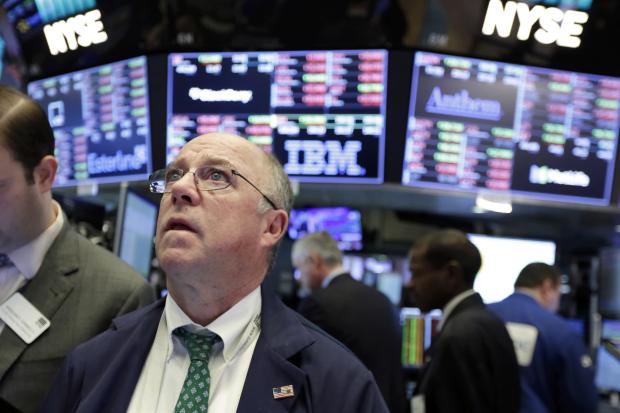Stocks plunge, then mostly recover as wild ride continues

Trader Frederick Reimer works on the floor of the New York Stock Exchange, Tuesday, Feb. 6, 2018. The Dow Jones industrial average fell as much as 500 points in early trading, bringing the index down 10 percent from the record high it reached on Jan. 26. The DJIA quickly recovered much of that loss. (Photo by RICHARD DREW / AP)
NEW YORK — The US stock market mostly recovered after an early plunge Tuesday and was down moderately in late morning trading, raising hopes of a halt to a global sell-off. The swings came one day after the steepest drop in 6 ½ years.
Major indexes in Asia and Europe also fell following Monday’s 1,175-point drop in the Dow Jones industrial average. Investors remain fearful that signs of rising inflation and higher interest rates could bring an end to the bull market that has sent stocks to record high after record high in recent years.
Trading was choppy Tuesday, which was likely to be one of the most watched days on the markets in years.
The Dow Jones industrial average fell as much as 567 points shortly after the opening bell, then jumped as much as 367 points in the first half-hour of trading.
The index, which is comprised of 30 big-name US companies, was down 108 points, or 0.4 percent, to 24,237 as of 11:25 a.m. The Standard & Poor’s 500 index, a broader market barometer that many index funds track, lost 18 points, or 0.7 percent, to 2,630. The Nasdaq composite shed 27 points, or 0.4 percent, to 6,939.
The steep drops Friday and Monday erased the gains the Dow and S&P 500 made since the beginning of the year, but both remain higher over the past 12 months. The Dow is still up 20 percent over that time, the S&P 500 15 percent.
After the sharp losses over the past three days, the S&P 500 is down 8.4 percent from the recent record high it set on January 26. That’s less than the 10 percent drop that is known on Wall Street as a “correction.”
Corrections are seen as entirely normal during bull markets, and even helpful in removing speculative gains and allowing new investors to buy into the market at lower prices. It has been an uncommonly long time since the last market correction, which ended almost two years ago.
In Tuesday’s trading, high-dividend companies including utility and real estate companies fell, as bond yields increased after a sharp drop on Monday. Retailers including Amazon and Home Depot made small gains, a possible sign of confidence the U.S. economy will keep growing.
The market mood turned decidedly fearful on Monday when the Dow Jones industrial average posted its biggest percentage decline since August 2011, driven by fears the US Federal Reserve will raise interest rates faster than expected due to a pick-up in wages. Those stemmed from the US jobs report on Friday.
That fed into widespread concerns that market prices were too high following a strong run over the past year that pushed many indexes to record highs.
Brent Schutte, chief investment strategist at Northwestern Mutual Wealth Management, said the plunge wasn’t caused by inflation fears alone. The markets have been unusually calm since late 2016, and he said investors were betting that would continue.
“People were positioned for more central bank easing or continued central bank easing, low rates, and importantly, low volatility,” he said. “Corrections are caused by people having to reposition for new environments.”
Schutte added that corrections can end quickly, and they often do so when investors see evidence of continued economic growth. Experts do think the global economy will keep growing this year even though that is likely to bring more inflation, but Schutte said that as central banks stop propping up the market, trading will probably be more volatile in the next few years.
Among the biggest losers Tuesday was Tokyo’s Nikkei 225 stock average, which ended 4.7 percent lower. Hong Kong’s Hang Seng skidded 5.1 percent and South Korea’s Kospi declined 1.5 percent.
In Europe, Germany’s DAX was down 2.1 percent and the CAC 40 in France lost 2 percent. The British FTSE 100 index fell 1.8 percent.
Bond prices edged lower after a big jump Monday. The yield on the 10-year Treasury note rose to 2.74 percent from 2.71 percent.
US crude oil fell 36 cents to $63.79 a barrel in New York. Brent crude, the international standards, lost 57 cents to $67.06 a barrel in London.
The dollar fell to 109.20 yen from 109.70 yen. The euro fell to $1.2355 from $1.2399.
On Monday, the Dow finished down 4.6 percent while the S&P 500 sank 4.1 percent, to 2,648.94. The last fall of that size came in August 2011 when investors were fretting over Europe’s debt crisis and the debt ceiling impasse in Washington that prompted a US credit rating downgrade.